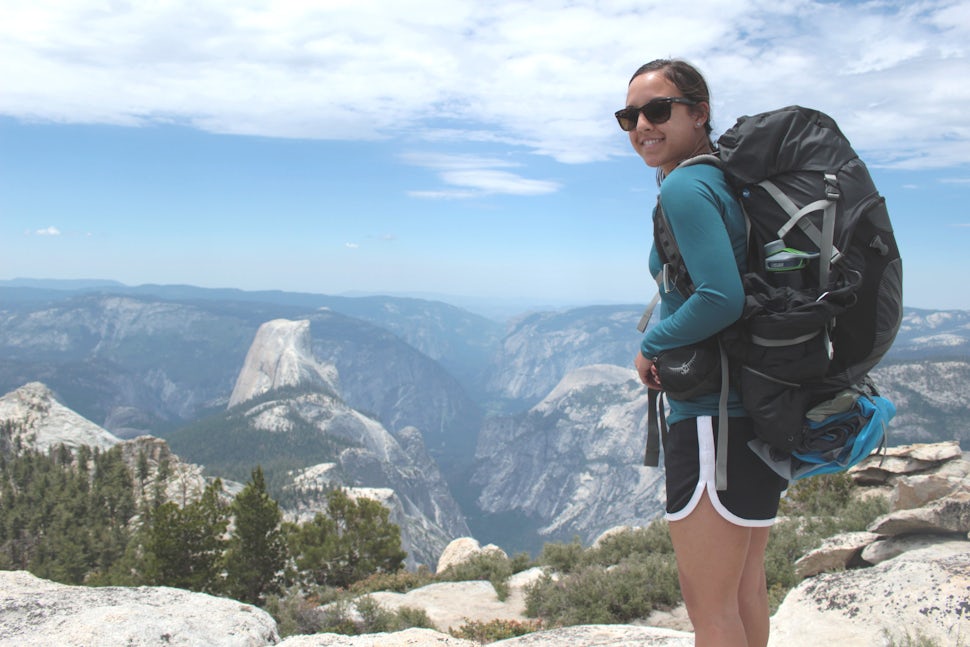Yes, You Can Use a Day Pack on Your Next Backpacking Trip
Packing light is easy when your pack is a 36L.

I'll be honest, I did not know I was purchasing a day pack when I bought my Osprey Stratos 36 at an REI garage sale. It looked like it was meant for backpacking with all its buckles and sturdy hip belt, and in my limited backpacking experience, I figured it would do the job. It fit me perfectly and was a total steal, and I've since gone on numerous trips throughout the Sierras with it. Mind you, they've all been 2-or-3-night trips, but somehow this baby has managed to hold everything I need. The best part is seeing my little pack next to the big 65L ones my friends are carrying, and knowing I've got a way lighter load.
So how do I get by with just a 36L pack? Here are some tips to turn your day pack into a fully loaded backpacking machine.
1. Invest in lightweight, packable gear.
When you only have so much space to play with, you need gear that will fit into that space. The only things that go inside my pack are a Mountain Hardwear synthetic sleeping bag that compresses to 8L, a lightweight North Face Thermoball jacket that packs into its own pocket, a small metal bear canister, a Jetboil stove with gas canister and bowl inside, and a blow-up pillow. I keep small things like my water filter, bug spray, utensils, and snacks in the the top pocket.
2. It's what's on the outside that counts.
Your pack has all those straps and exterior pockets for a reason. I roll up my rain jacket and strap it to the outside so it's within reach in case it rains. I split the tent and tent poles/rain fly with my partner and keep my half strapped below my pack. Then I clip everything that can be clipped to the outside straps. A small bottle of sunscreen clips to my shoulder strap, camp sandals clip on the back, and sometimes I'll take a mini frying pan if we're planning on quesadillas or pancakes later. I may look like Samwise the Brave from The Lord of the Rings, but all the jingling helps warn the bears, so there's that. And don't forget your pockets! I keep a map in my back pocket and little things like lip balm and AirHeads (my backpacking must-have) in my side pockets.
3. Roll your clothes inside your sleeping pad.
This was a game changer for me. I have the REI Cirrus air pad that you pump up using your hands. It's really lightweight and lies completely flat when not pumped up. If it rips or pops, I'm totally screwed since there's no extra foam padding, but I always keep a strip of duct tape wrapped around my water bottle in case I need it for this reason. Since the pad lies flat, there's tons of room to roll all my clothes into it, then I strap it below my pack.
4. Your bear canister can store more than food.
When I started backpacking, I would almost never eat all the food I packed. With experience, I learned just how much I really need, and this has freed up a lot of space in my bear canister. I can store my pillow, extra socks, or other little odds and ends in there to save room.
5. Don't use the water bladder.
I always use two water bottles and leave my water bladder at home; it just takes up space inside the pack. Plus, it's tough to tell how much water you have left when it's hidden inside your pack. Use tall and narrow bottles; Hydroflask and Nalgene have some good ones. Or, as one seasoned PCT hiker once told me, fit two Smart Water Bottles per side for a total of four water bottles.
6. Leave most of your camera gear at home.
I somehow do find space to bring my Canon Rebel SL1 camera, but I only take a 24mm pancake lens. I hike with it strapped diagonally across my chest so it's always at the ready, but I'll store it inside a Ziploc bag in case it rains. I don't take a special camera bag but just wrap it up in my deflated pillow for a little extra padding. But these days, the cameras on our phones do the job and take up a lot less space.
7. Know your pack.
The best piece of advice I can give is to know each and every corner of your pack. Even when it looks like it's about to explode, I know I can fit one more pair of socks into that bottom corner or rearrange the top pocket to fit one last Clif Bar. I also know Osprey makes a great pack. The material (ripstop nylon) is heavy duty and can handle being packed to the brim. And I take the time when decamping to repack properly. Even though I want to just toss everything in and get going, it's always better to stay organized and know where everything is.
We want to acknowledge and thank the past, present, and future generations of all Native Nations and Indigenous Peoples whose ancestral lands we travel, explore, and play on. Always practice Leave No Trace ethics on your adventures and follow local regulations. Please explore responsibly!
Do you love the outdoors?
Yep, us too. That's why we send you the best local adventures, stories, and expert advice, right to your inbox.







